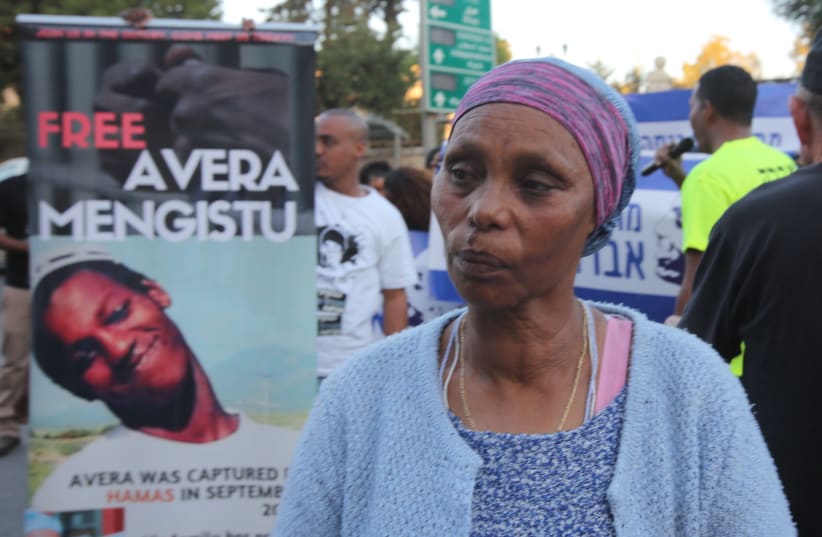Prime Minister Benjamin Netanyahu almost made it look too easy.
An Israeli woman entered Syria and was arrested. Netanyahu made a few phone calls to Russia and held a secret government meeting. Within weeks he had secured her release in exchange for the return of two Syrian shepherds – and according to unconfirmed reports, a promise to purchase COVID-19 Sputnik vaccines from Russia for use in Syria.
The prisoner swap happened so quickly at the end of last week that the public barely learned an Israeli Jewish woman had been held in Syria before she was already safely back in Israel.
The speed begs the obvious question. If so much can happen in so little time for so small a price with the enemy state of Syria, why can’t Israel do the same with the hostage situation in the Hamas-ruled Gaza Strip, which is not even a state?
Here on Israel’s southern border, the situation is completely the opposite.
Six years on, Netanyahu has failed to secure the release of the remains of two IDF soldiers killed in 2014 – Lt. Hadar Goldin and St.-Sgt. Oron Shaul.
Nor has he freed two Israeli men: Avera Mengistu who wandered into Gaza in September 2014 and Hisham al-Sayed who entered Gaza in 2015. Both men are believed to be suffering from mental illness.
Upon hearing of the Syrian deal, Hadar’s father, Simcha Goldin, bitterly stated that Netanyahu “has done nothing” on his son’s behalf.
To the casual eye, it would be simple to chalk the situation up to the difference between soldiers who are believed to be dead and a woman who is alive. Then there is the charge that racism is at play and that the delay in securing the release is tied to the fact that Mengistu is Ethiopian and al-Sayed is Bedouin.
GERSHON BASKIN, a Jerusalem Post columnist, with a history of negotiating with Hamas, said that while racism could possibly have come into play with regard to the absence of a public Israeli campaign to release the men, it had nothing to do with the actual negotiations for their freedom.
Both he and Eran Lerman, vice president of the Jerusalem Institute for Strategy and Security, described in separate conversations with the Post the complex geopolitical factors that made one release go smoothly while the other almost seems like a “mission impossible.”
At issue, both men said, is the difference between Syria’s realistic and Hamas’s unrealistic demands, as well as the role of Russia versus Egypt as interlocutors.
Israel would clearly want to secure the release of the two bodies and the two men, Lerman said. If Hamas had asked for the release from Israeli jails of say, 10 Palestinians from Gaza who had crossed into Israel and to cut short the sentence of 15 others, a prisoner swap would have already occurred, Lerman said.
This is not about skin color: It is about the level of Hamas demands, he said.
“The reason this is not moving forward is that Hamas demands are unrealistic. If Hamas would show a modicum of the same common sense, we would have been in a different place,” Lerman said.
The Syrians treated the Israeli woman as a “hot potato,” acting quickly to end the situation, particularly by putting forward realistic demands, he added.
Initially, Hamas had hoped to achieve a deal on the scale of the 1,027 Palestinian prisoners Israel freed in 2011 in exchange for IDF soldier Gilad Schalit, who had been held captive in Gaza for five years.
Baskin, who opened a back channel to help negotiate that release, said that Hamas had made initial pledges to its public about a large prisoner swap, such that any deal Israel would accept would be viewed as a public defeat.
Hamas demands included the release of prisoners responsible for killing Israelis, Baskin explained.
“Israel agrees to release prisoners but not anyone who has killed Israelis,” he said.
THE SITUATION with Syria was also made easier by the strong relationship Russian President Vladimir Putin has with both Netanyahu and Syrian President Bashar Assad, Lerman said, adding that both sides made the deal with Putin.
Egypt, in contrast, is the middle man between Israel and Hamas, but “there is no love lost” between Egypt and Hamas, Lerman said.
Baskin added that there is little trust between Israel and Hamas, with the terrorist group already believing that Israel has broken the Schalit deal by rearresting 68 of the released prisoners in 2014, of whom 42 are still in prison.
Lastly, a prisoner swap at the level of Hamas demands does not happen in a vacuum and has to be seen within the larger context of past exchanges.
In what is known as the Jibril deal, Israel in 1985 agreed to free 1,150 Palestinian prisoners in exchange for the release of three IDF soldiers captured during the First Lebanon War: Yosef Grof, Nissim Salem and Hezi Shai.
Among the prisoners were those involved in significant terror attacks – and some prisoners who were freed helped launch the First Intifada.
As a result of the backlash from that prisoner exchange, Israel hesitated to make a deal for the release of air-force officer Ron Arad, who was captured in 1986 and was held by Hezbollah in Lebanon. Initially Israeli knew of his whereabouts, but lost all traces of him in 1988 – and he has been missing ever since.
In that same way, the fate of Goldin, Shaul, Mengistu and Al-Sayed can be seen in the context of the Schalit deal, which demanded a similarly high price, which Israel is unwilling to pay again.
“There is a kind of trauma left over from the Schalit deal,” Baskin said.
“Both sides have to compromise. Hamas has to lower its demands and Israel has to increase what it is willing to give,” he said. “It’s time to end this chapter, time to bring them home” from Gaza.
